Search
- Page Path
- HOME > Search
- [English]
- Eco-Friendly Powder and Particles-Based Triboelectric Energy Harvesters
- Rayyan Ali Shaukat, Jihun Choi, Chang Kyu Jeong
- J Powder Mater. 2023;30(6):528-535. Published online December 1, 2023
- DOI: https://doi.org/10.4150/KPMI.2023.30.6.528
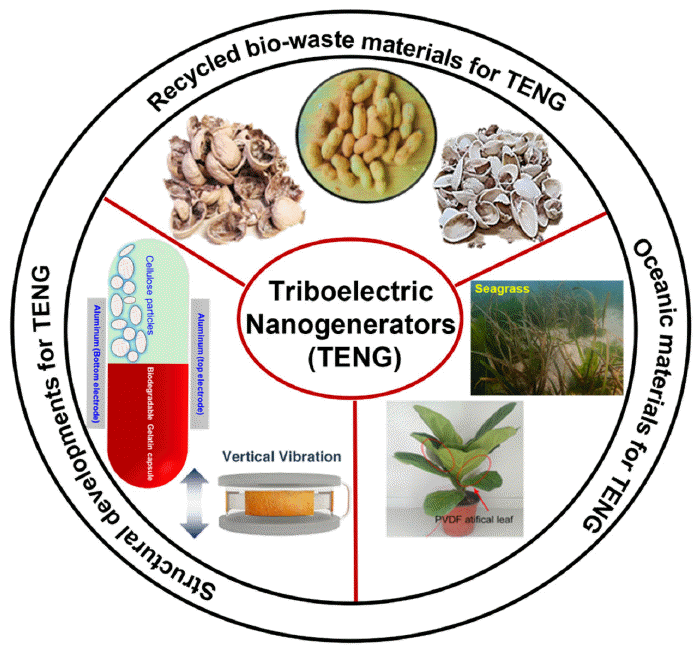
- 1,555 View
- 33 Download
- 2 Citations
-
 Abstract
Abstract
 PDF
PDF Since their initial development in 2012, triboelectric nanogenerators (TENGs) have gained popularity worldwide as a desired option for harnessing energy. The urgent demand for TENGs is attributed to their novel structural design, low cost, and use of large-scale materials. The output performance of a TENG depends on the surface charge density of the friction layers. Several recycled and biowaste materials have been explored as friction layers to enhance the output performance of TENGs. Natural and oceanic biomaterials have also been investigated as alternatives for improving the performance of TENG devices. Moreover, structural innovations have been made in TENGs to develop highly efficient devices. This review summarizes the recent developments in recycling and biowaste materials for TENG devices. The potential of natural and oceanic biowaste materials is also discussed. Finally, future outlooks for the structural developments in TENG devices are presented.
-
Citations
Citations to this article as recorded by- Fabrication and Characterization of a Flexible Polyurethane-Based Triboelectric Nanogenerator for a Harvesting Energy System
Saba Ejaz, Imran Shah, Shahid Aziz, Gul Hassan, Ahmed Shuja, Muhammad Asif Khan, Dong-Won Jung
Micromachines.2025; 16(2): 230. CrossRef - Optimized Process and Mechanical and Electrical Analysis of Polyimide/Pb(Zr,Ti)O3-Based Flexible Piezoelectric Composites
Junki Lee, Sang-il Yoon, Hyunseung Kim, Chang Kyu Jeong
Journal of Powder Materials.2025; 32(1): 16. CrossRef
- Fabrication and Characterization of a Flexible Polyurethane-Based Triboelectric Nanogenerator for a Harvesting Energy System
- [Korean]
- Controlling Particle Size of Recycled Copper Oxide Powder for Copper Thermite Welding Characteristics
- Hansung Lee, Minsu Kim, Byungmin Ahn
- J Powder Mater. 2023;30(4):332-338. Published online August 1, 2023
- DOI: https://doi.org/10.4150/KPMI.2023.30.4.332
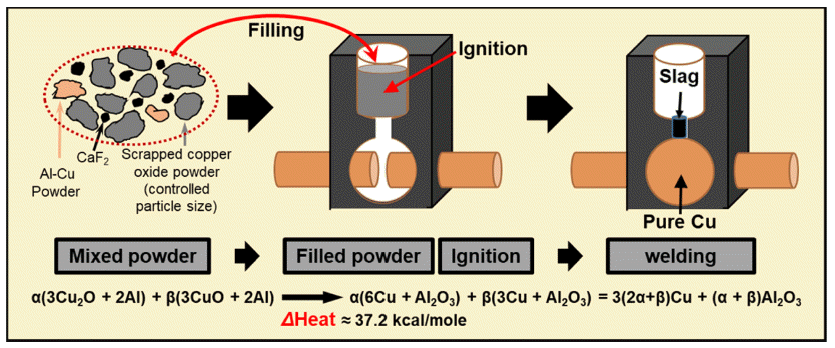
- 685 View
- 7 Download
- 1 Citations
-
 Abstract
Abstract
 PDF
PDF Thermite welding is an exceptional process that does not require additional energy supplies, resulting in welded joints that exhibit mechanical properties and conductivity equivalent to those of the parent materials. The global adoption of thermite welding is growing across various industries. However, in Korea, limited research is being conducted on the core technology of thermite welding. Currently, domestic production of thermite powder in Korea involves recycling copper oxide (CuO). Unfortunately, controlling the particle size of waste CuO poses challenges, leading to the unwanted formation of pores and cracks during thermite welding. In this study, we investigate the influence of powder particle size on thermite welding in the production of Cu-thermite powder using waste CuO. We conduct the ball milling process for 0.5–24 h using recycled CuO. The evolution of the powder shape and size is analyzed using particle size analysis and scanning electron microscopy (SEM). Furthermore, we examine the thermal reaction characteristics through differential scanning calorimetry. Additionally, the microstructures of the welded samples are observed using optical microscopy and SEM to evaluate the impact of powder particle size on weldability. Lastly, hardness measurements are performed to assess the strengths of the welded materials.
-
Citations
Citations to this article as recorded by- Friction Welding of Casted SCM440 and Sintered F-05-140 Dissimilar Steels and Their Joint Properties under Various Welding Conditions
Jisung Lee, Hansung Lee, Eunhyo Song, Byungmin Ahn
Journal of Powder Materials.2024; 31(5): 414. CrossRef
- Friction Welding of Casted SCM440 and Sintered F-05-140 Dissimilar Steels and Their Joint Properties under Various Welding Conditions
- [Korean]
- A Study on the Preparation of Rare Earth Oxide Powder for Rare Earth Precipitates Recovered from Spent Ni-MH Batteries
- Dae-Weon Kim, Nak-Kyoon Ahn, Hyun-Woo Shim, Kyung-Soo Park, Hee-Lack Choi
- J Korean Powder Metall Inst. 2018;25(3):213-219. Published online June 1, 2018
- DOI: https://doi.org/10.4150/KPMI.2018.25.3.213
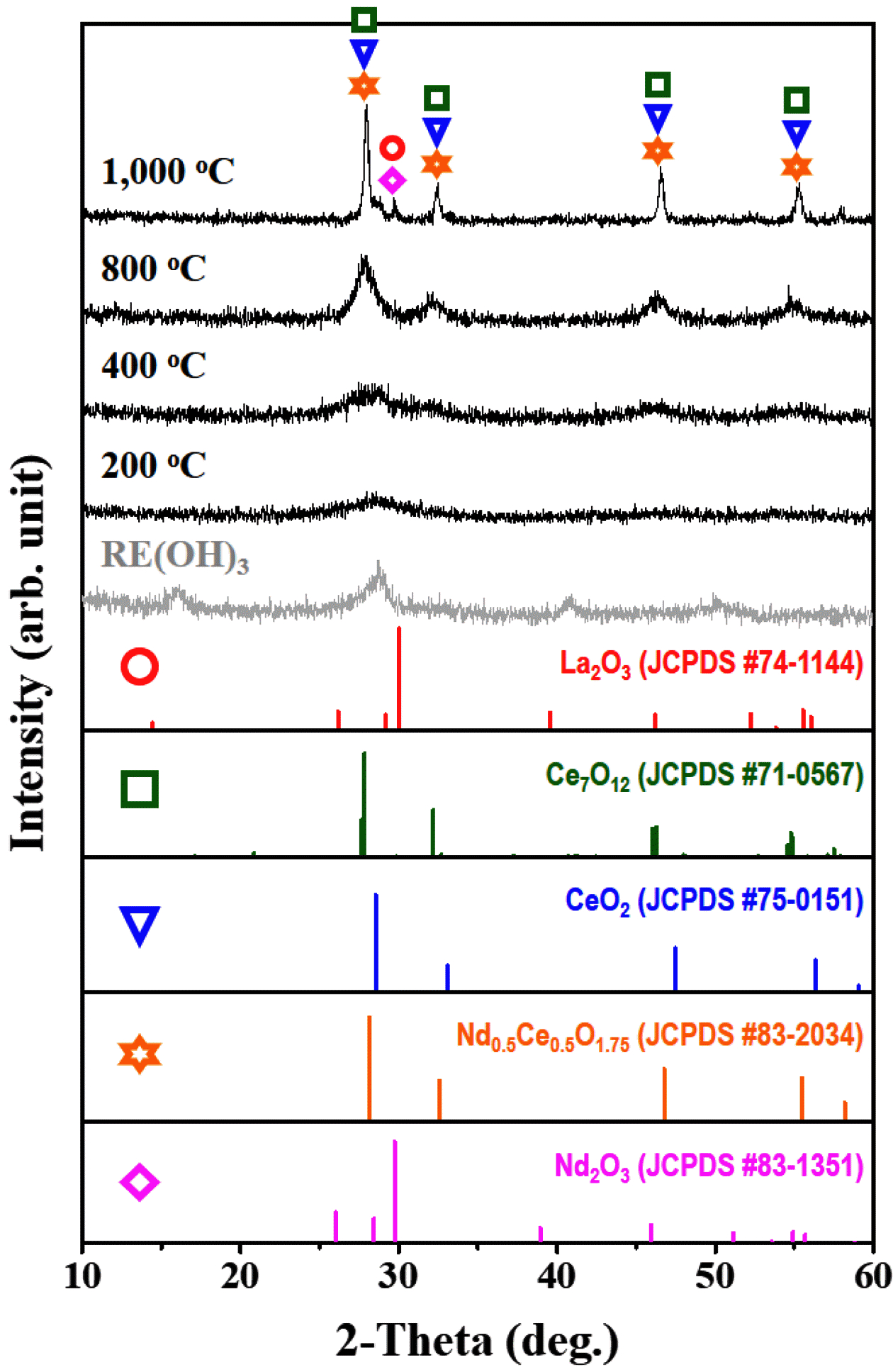
- 485 View
- 2 Download
- 2 Citations
-
 Abstract
Abstract
 PDF
PDF We report a method for preparing rare earth oxides (RexOy) from the recycling process for spent Ni-metal hydride (Ni-MH) batteries. This process first involves a leaching of spent Ni-MH powders with sulfuric acid at 90°C, resulting in rare earth precipitates (i.e., NaRE(SO4)2·H2O, RE = La, Ce, Nd), which are converted into rare earth oxides via two different approaches: i) simple heat treatment in air, and ii) metathesis reaction with NaOH at 70°C. Not only the morphological features but also the crystallographic structures of all products are systematically investigated using field-emission scanning electron microscopy (FESEM) and X-ray diffraction (XRD); their thermal behaviors are also analyzed. In particular, XRD results show that some of the rare earth precipitates are converted into oxide form (such as La2O3, Ce2O3, and Nd2O3) with heat treatment at 1200°C; however, secondary peaks are also observed. On the other hand, rare earth oxides, RexOy can be successfully obtained after metathesis of rare earth precipitates, followed by heat treatment at 1000°C in air, along with a change of crystallographic structures, i.e., NaRE(SO4)2·H2O → RE(OH)3 →RexOy.
-
Citations
Citations to this article as recorded by- Recycling of Rechargeable Batteries: Insights from a Bibliometrics‐Based Analysis of Emerging Publishing and Research Trends
Jiao Lin, Xiaodong Zhang, Li Cai, Ersha Fan, Shumeng Wu, Su Ma, Feng Wu, Renjie Chen, Li Li
Advanced Energy and Sustainability Research.2022;[Epub] CrossRef -
Synthesis of Rare Earth Oxide from NaREE(SO4)2·H2O by Ion Substitution Reaction
Dae-Weon Kim, Bo-Ram Kim, Hee-Lack Choi
Journal of the Korean Society of Mineral and Energy Resources Engineers.2020; 57(5): 405. CrossRef
- Recycling of Rechargeable Batteries: Insights from a Bibliometrics‐Based Analysis of Emerging Publishing and Research Trends
- [English]
- Environment Emission and Material Flow Analysis of Chromium in Korea
- Dong-won Shin, Jeong-gon Kim
- J Korean Powder Metall Inst. 2015;22(3):187-196. Published online June 1, 2015
- DOI: https://doi.org/10.4150/KPMI.2015.22.3.187
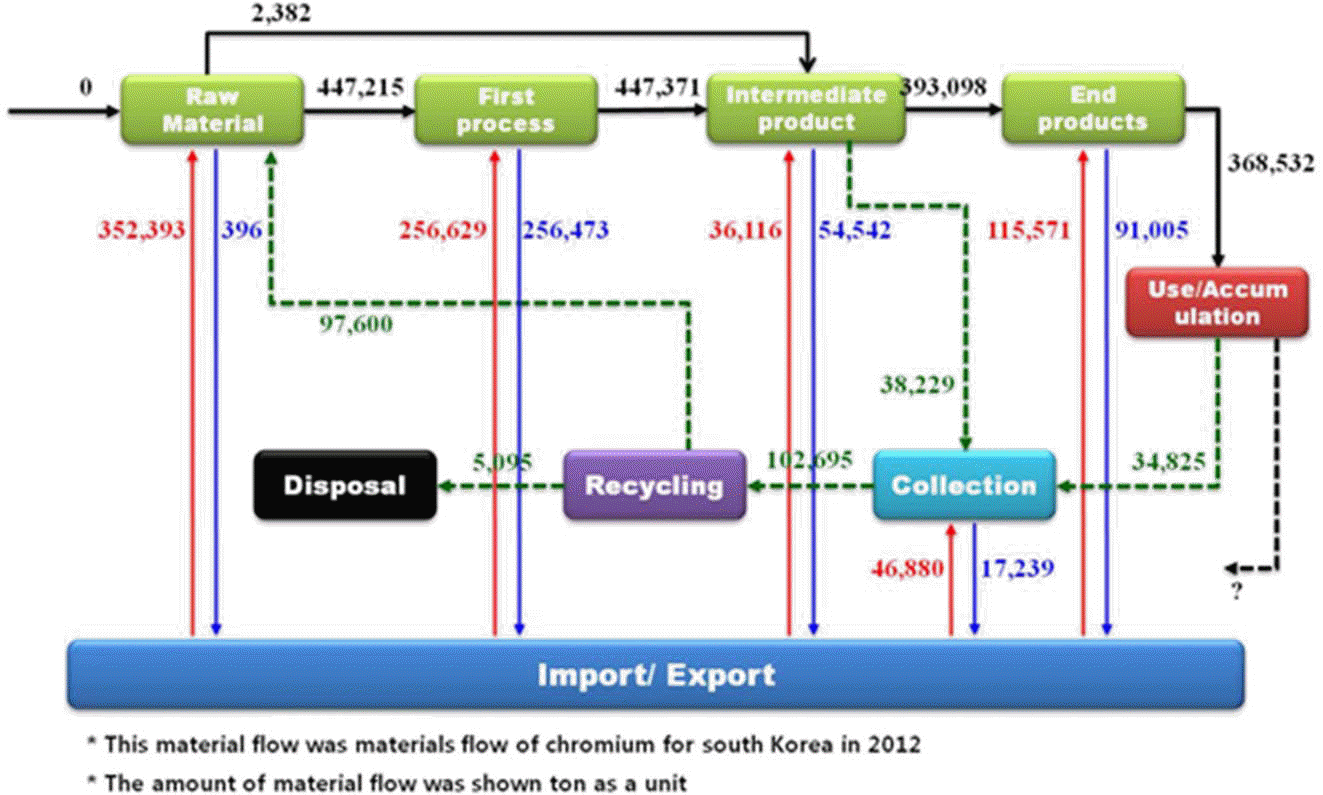
- 513 View
- 1 Download
-
 Abstract
Abstract
 PDF
PDF With the stabilization of Korea’s industrialization, it has become interested in the efficient use of rare metals, climate change and industrial environment and safety etc. It is thus making efforts to implement economic policies that address such issues. Therefore it is necessary to understand the demand, supply and use of metal materials. Since 2010, the Korean government has developed the integrated material flow methodology and has been trying to examine the demand, supply and use of metal materials. In 2013, the Korean government surveyed the material flow of chromium. Material flow analysis and environment emission of chromium were investigated 8 steps; (1) raw material, (2) first process, (3) Intermediate product, (4) End product, (5) Use/accumulation, (6) Collection, (7) Recycling, (8) Disposal. Chromium was used for stainless steel, alloy steel, coated sheets, refractory material and coating materials. Recycling was done mainly in use of stainless steel scrap. To ensure efficient use of chromium, process improvement is required to reduce the scrap in the intermediate product stage. In the process of producing of the products using chromium, it was confirmed that chromium was exposed to the environment. It requires more attention and protection against environment emission of chromium.
- [Korean]
- Preparation of Cathode Materials for Lithium Rechargeable Batteries using Transition Metals Recycled from Li(Ni1-x-yCoxMny)O2 Secondary Battery Scraps
- Jae-won Lee, Dae Weon Kim, Seong Tae Jang
- J Korean Powder Metall Inst. 2014;21(2):131-136. Published online April 1, 2014
- DOI: https://doi.org/10.4150/KPMI.2014.21.2.131
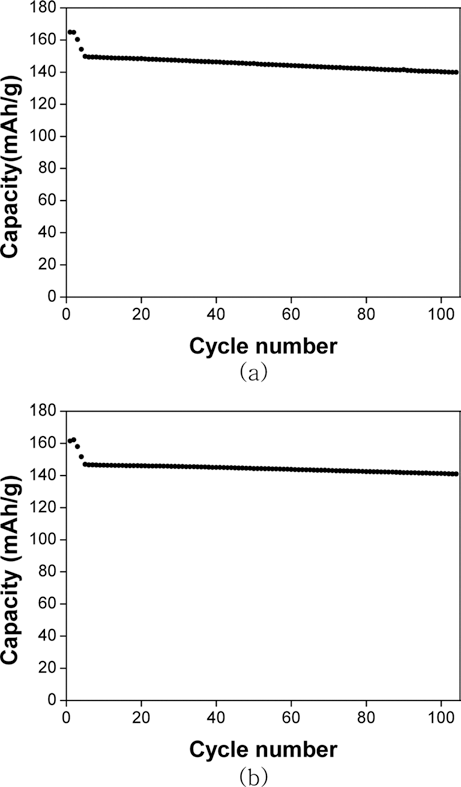
- 503 View
- 3 Download
-
 Abstract
Abstract
 PDF
PDF Cathode materials and their precursors are prepared with transition metal solutions recycled from the the waste lithium-ion batteries containing NCM (nickel-cobalt-manganese) cathodes by a H2 and C-reduction process. The recycled transition metal sulfate solutions are used in a co-precipitation process in a CSTR reactor to obtain the transition metal hydroxide. The NCM cathode materials (Ni:Mn:Co=5:3:2) are prepared from the transition metal hydroxide by calcining with lithium carbonate. X-ray diffraction and scanning electron microscopy analyses show that the cathode material has a layered structure and particle size of about 10 μm. The cathode materials also exhibited a capacity of about 160 mAh/g with a retention rate of 93~96% after 100 cycles.
TOP
 KPMI
KPMI


 First
First Prev
Prev


